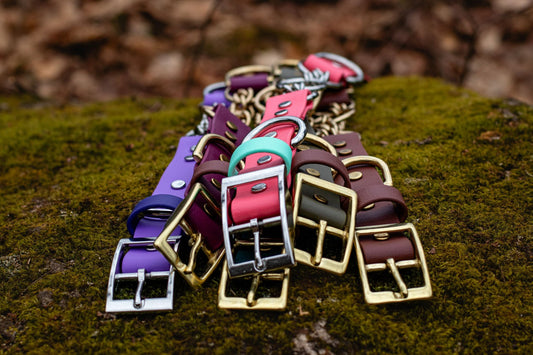
Brass vs. Stainless Steel: What You Need to Know About Hardware Staining
Amanda MorrisonPartager
Why it happens, how to prevent it, and which hardware is best for your dog.
At Backwoods Dog, we’re committed to making gear that lasts through every muddy trail, snow trek, and forest hike. But one of the most common questions we get from customers is:
“Why is my dog’s neck turning green?”
Let’s break it down.

🟡 What Causes Brass Staining?
We use solid brass hardware for many of our collars because it’s:
- Incredibly strong and durable
- Naturally corrosion-resistant
- Beautiful and develops a rich patina over time
But… brass can oxidize. That means it reacts with moisture, air, and your dog’s natural skin and coat oils—especially on light-coloured fur—resulting in greenish or grey discoloration where the hardware sits.
This is a natural process (just like copper turning green), and it’s completely harmless—but understandably not everyone loves the look.
⚙️ Brass vs. Stainless Steel: Pros & Cons

👉 Bottom Line:
Brass is beautiful and timeless, but requires more care and is prone to surface staining.
Stainless is low-maintenance and ideal for those who want a “set it and forget it” collar.

🧽 Tips to Clean and Maintain Your Hardware
If you’ve noticed staining, here’s how to clean and keep it away:
1. Clean the hardware regularly
Use a damp cloth and mild soap to wipe down the hardware after wet, muddy, or long adventures.
2. Deep clean with a pet-safe polish
Try a non-toxic metal polish (scroll down for a list of pet-safe products) sparingly, and always rinse thoroughly afterward. Avoid harsh chemicals or ammonia-based cleaners.
3. Apply a protective barrier
This tip is gold: Use a small dab of coconut oil or paw balm on the back of the brass hardware where it touches your dog’s coat. This helps reduce direct contact and slows oxidation.
4. Keep it dry
After hikes, lake dips, or rainstorms, dry the collar with a towel. Storing wet gear in damp areas speeds up staining.

🧼 What If the Fur Is Already Stained?
If your dog has developed a greenish or dark stain on their fur from brass hardware—don’t worry. It’s common, and it usually fades over time, especially as the coat sheds or is washed.
But if you want to help speed things along:
🐕🦺 Natural & Dog-Safe Cleaning Tips:
-
Diluted Apple Cider Vinegar Rinse
Mix 1 part apple cider vinegar with 2 parts water, and lightly dab the stained fur with a cloth or spray bottle. Wipe clean with a damp cloth afterward. This gently lifts oxidation without irritating the skin.
-
Dog-Safe Baking Soda Paste
Mix a little baking soda with water to form a paste, and massage it gently into the fur. Let it sit for 2–3 minutes, then wipe off with a damp cloth and rinse thoroughly. It can help lift stains naturally.
-
Use a Mild Dog Shampoo
If needed, follow with your regular dog shampoo to remove any residue. Be sure to avoid harsh soaps or anything with whitening agents.
🐾 Tip: Keep an eye on your dog’s skin. While brass staining is cosmetic, some pups with sensitive skin may benefit from switching to stainless.
🧴 Pet-Safe Brass Polishes (Available in Canada)
Hope’s Brass Polish
Features: Ammonia-free, safe for untreated and unlacquered brass, copper, chrome, and sterling silver.
Wright’s Brass Polish
Features: Water-based, non-abrasive formula that eliminates tedious buffing.
Weiman Brass Polish
Features: Safely cleans and shines brass, copper, chrome, bronze, and pewter; removes tarnish and rinses off easily.
Frankford Arsenal Brass Polish
Features: Ammonia-free, non-hazardous solution with a citrus fragrance.
🌿 Natural DIY Brass Cleaning Alternatives
For those preferring natural solutions, here are some effective, pet-safe methods:
-
Lemon Juice & Baking Soda Paste
How to Use: Mix equal parts lemon juice and baking soda to form a paste. Apply to brass, let sit for a few minutes, then rinse and dry.
-
Vinegar and Salt Solution
How to Use: Combine equal parts white vinegar and water, and add enough salt to form a paste. Apply to brass, let sit briefly, then buff and rinse.
-
Olive Oil and Vinegar Polish
How to Use: Apply a small amount of olive oil to a soft cloth, then dampen another cloth with white vinegar. Rub the brass surface with the olive oil-soaked cloth to polish and restore shine, then use the vinegar-dampened cloth to remove excess oil and residue.
-
Ketchup Application
How to Use: Apply a thin layer of ketchup to the brass, let it sit for a few minutes, then wipe clean with a damp cloth and dry thoroughly.
Note: Always test any cleaning method on a small, inconspicuous area first to ensure it doesn't adversely affect the material.
Real Talk: Is This Covered Under Warranty?
Because brass staining is a natural property of the material (and varies by dog), it’s not considered a product defect. However, if you’ve had a bad experience with it, we care—and we’re here to help.
If you want to switch to stainless, we’re happy to offer a loyalty discount for repeat customers who want a low-maintenance option.
Final Thoughts
We believe in gear that’s not just tough, but smart, adaptable, and beautiful. We love the rugged beauty of brass—but we also know it's not for everyone. Whether you’re all in on patina, or you’d prefer a low-maintenance stainless collar, we’re here to support your adventures with real answers, real solutions, and gear built to go the distance.
Still unsure? Message us—we’ll help you find the right hardware for your pup’s coat, habits, and lifestyle.




